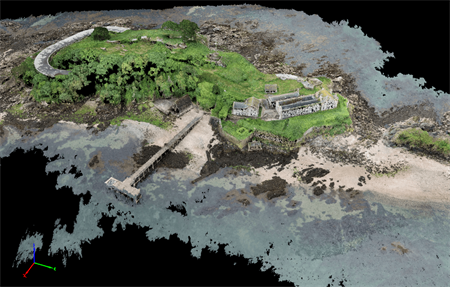
A team of University simulation specialists from Birmingham were granted unique access to Drake’s Island in Plymouth Sound to undertake a whirlwind survey for the collection of data to develop a detailed Virtual Reality (VR) model of the entire Island in just a day!
This VR survey captured the historic remains of the Island as they exist today, in advance of any potential commercial development that will, most likely, change the face of the location forever.
Led by Plymouth-born Professor Bob Stone, the University of Birmingham’s Human Interface Technologies Team is no stranger to undertaking challenging land, sea and subsea heritage projects in the Plymouth area. The team are also experienced in organising defence VR training projects with the Royal Navy and Royal Marines. For example, this Drake’s Island project follows the HIT Team’s recent successful survey of Burrator Reservoir which converted the sonar data from a small autonomous surface vessel into a 3D VR “map” of what lies beneath. This data was then used to pinpoint the remains of two long-forgotten World War II anti torpedo nets.
The researchers used similar technologies drone to map as much of the overground topography and detail of the Island as possible in just a day! By converting drone video footage into fully textured 3D models, it was possible to use the 3D result, in conjunction with 360 camera technologies, standard video, thermal imagery and a scanning laser, to develop an interactive historical record of the Island – including the buildings, gun emplacements and tunnels – for future educational applications.
To the team's delight, the weather conditions had allowed them to fly two hours of flight successfully that covered much of the Island to obtain sufficient video footage for the subsequent 3D modelling process. They undertook 96 360o panoramic scans of all of the remaining dark and long-abandoned tunnels, gun emplacements, magazines, shell hoists and other features from the Island’s incredible history, backed up with 5564 high-res photos. The day was topped for the team by flying a Devon flag on a drone to celebrate Devonshire Day on 4 June 2019!
Professor Stone said, “Ever since I looked out onto Plymouth Sound from the prefects’ room in Sutton High School, many decades ago, it was always my hope one day to be able to visit Drake’s Island. We’re really grateful to the current owners of Drake’s Island, Rotolok Group, and to their project coordinator, island “gatekeeper” and historian, Bob King, for helping us to gain access to the site and capture an important West Country heritage asset. Thanks also go to the Port of Plymouth Harbour Master’s office, and to the Queen’s Harbour Master, Plymouth, with whom we’ve worked before, to gain support to undertake drone flying in the Sound. I’m hopeful that the end result of this intensive two-day mission will provide a unique historical and record and a foundation on which we and others can record and develop an interactive historical asset for public and schoolchildren alike.”
Historical records for Drake’s Island show that the small natural structure in Plymouth Sound, formed of volcanic rock and marine limestone, was originally known in the 12th Century as St Michael’s Isle (after the chapel built there), later St. Nicholas’ Isle. Sir Francis Drake set sail from the Island in 1577, returning three years later after circumnavigating the globe. In a further three years, Drake was to become the governor of the Island. From 1549 the island was fortified and endowed with extensive barracks to defend Plymouth against the French and Spanish. The Island was “home” to a number of prisoners during its turbulent history, including key supporters of the English Parliament (“Roundheads”) and traitors during the Civil War of 1641 to 1652. Of relevance to one the University’s previous virtual maritime heritage projects, the Island was witness to the world’s first recorded submarine fatality in June 1774, when a sailing vessel, the Maria, modified with a wooden diving chamber, failed to surface, killing its single occupant, carpenter John Day. Read the full article.
The remains of defences evident on the Island today - fortified gun emplacements (or “casements”), underground magazines with tunnel networks and military accommodation – date mostly from the mid-nineteenth century. The Island hosted a garrison of nearly 500 soldiers during World War II supporting coastal defence and anti-aircraft operations, helping to protect both the city and the naval dockyard at Devonport. In the 1960s the Island became an Adventure Centre for children of all ages and abilities, finally closing its door in 1989. The Mayflower Centre Trust operated the training scheme until 31 March 1989 and Drake's Island Adventure Centre which was opened in 1964.